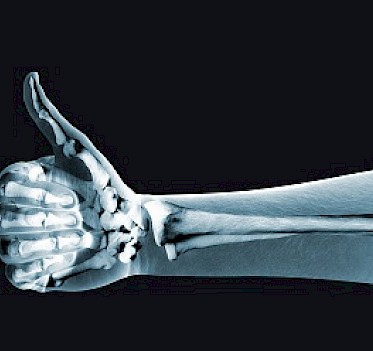X Marks the Spot for X-Rays
Whether you remember it or not, chances are you have had an x-ray at least once in your life either during a doctor’s visit, or while you’re at the dentist. X-rays are one of the most common ways to diagnose if your kid has swallowed a penny or not, among other things that this tool is used for— “tools” meaning x-rays, not pennies. Here at HealthCARE Express, we’ll be the first to admit that sometimes x-rays can come across as scary, especially if it’s your first one. If you don’t know what you’re looking at, then that’s scary too, but not to worry because our healthcare professionals have a trained eye in understanding the importance of x-rays and how to read them. Keep reading to learn what exactly an x-ray is, why you might need an x-ray, if there are any risks when getting an x-ray, and to learn more about HealthCARE Express.
What is an X-Ray?
An x-ray is a machine that uses a type of radiation called electromagnetic waves that creates images of what the inside of your body looks like. This type of radiation has been around since the 1800s where a German physicists named it X-radiation because he didn’t know what it was, and the term X-ray has stuck since then. X-rays only appear in black and white due to the different tissues absorbing the radiation. Calcium in your bones absorbs the most so they appear white whereas fat and other tissues in your body absorb less, so those parts will appear to be gray. And of course, air absorbs the least amount of radiation, that’s why the lungs appear to be black. The images produced from an x-ray can show you abnormalities inside the body like if your kid did swallow a penny. But on a more serious note, it could show if you have a fracture, lung problem, bowel obstruction, or other serious problems.
Why Would I Need an X-Ray?
The most common use of an x-ray is to check for bone fractures, but they can also be used for numerous other reasons including:
- Chest x-rays (to spot pneumonia)
- Mammograms use x-rays (to spot breast cancer)
- Broken bones
- Lung problems
- Bowel problems
- Heart conditions
- Spot tumors
- Spot scar tissue from infections
- Bodily blockages
- To see the size of your heart *cue the Grinch x-raying his heart*
If you’re unsure whether or not an x-ray is necessary, talk it over with your doctor or trusted healthcare professional. Here at HealthCARE Express, it is our #1 priority to do everything we can to ensure you have a comfortable and positive experience no matter what service we provide to you.
Are There Risks with Getting an X-Ray?
The simple answer is yes, there are risks when getting an x-ray. But the risks are so minimal that there’s no need to panic. If you need an x-ray, you will wear a lead apron as a way to protect certain parts of your body that are not being x-rayed. The amount of radiation you get from an x-ray is really small, in fact, most x-rays give out less radiation than what you’re naturally exposed to within the environment over the span of 10 days. We guarantee that x-rays are safe because they use naturally occurring electromagnetic radiation that we’re exposed to every day without knowing. Advances in technology have decreased the amount of radiation from x-rays even further as well. Still though, we always take extra precautions like having the patient wear a lead apron, etc. to ensure there is no unnecessary exposure to you or our team.
HealthCARE Express Has In-House X-Rays
Our healthcare providers at any of our 17 urgent care locations have x-ray services where we are able to treat minor bone fractures, offer affordable pricing, and provide you with friendly, knowledgeable, and professional care. Aside from x-rays, we offer numerous other services all at an affordable price. Feel free to explore our website to find out more about what we do here at HealthCARE Express. Check out our locations page to find an urgent care close to you with the appropriate phone number that services your location. Help us help you with all your healthcare needs.
